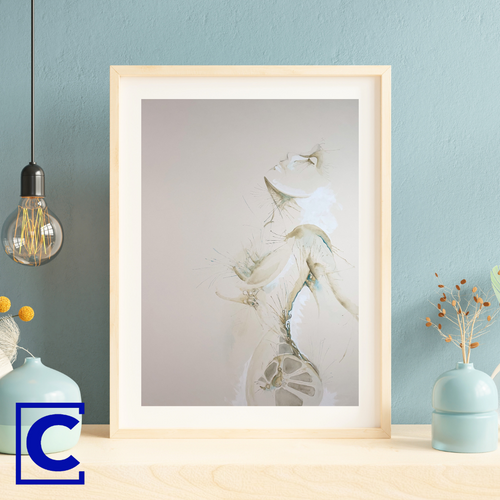
Framing brilliance: a guide for artists on choosing the right glass
|
|
Time to read 4 min
|
|
Time to read 4 min
Learn the wide variety of glass choices that are commonly used in picture framing and gain the knowledge about the unique characteristics and benefits they provide.
Artists, as you prepare to frame your art, do not underestimate the value of glazing. Let's look at how Crestar can help you choose the right glass that matches your work and how it will increase its chances of success. We offer glazing options from Tru Vue, including;
We have many glass options to consider to suit any piece of your artwork. Although the many options may look a bit overwhelming, we are here to help you along with all the benefits that each glass provides.
UV-protective glass is specifically designed to block harmful ultraviolet (UV) rays from reaching the artwork. These rays will cause fading, discoloration, and deterioration of the artwork over time. UV-protective glass helps to preserve the original colors and integrity of the artwork, making it ideal for valuable or sensitive pieces. UV glass is good for preserving what matters especially if it is near areas with any UV light. We always recommend UV glazing (either glass or acrylic), as it is simply the best choice long term.
Museum glass is a high-quality glass that offers superior clarity and virtually eliminates reflection. It is specially treated to reduce glare and provide a clear and unobstructed view of the artwork. What is great about Museum glass is that it is truly invisible, while protecting the art from UV. It is expensive, but the clarity and protection it brings is amazing. If you can, choose Museum glass, remember it is your art that will be behind the glass, so choose the best.
If you can’t justify the museum prices for your glass, we have an option: a non-reflective glass with less UV protection. It is still pretty good, with 78% UV protection, but with the same invisible look as museum glass! For us, it is the art that counts, and so this is a great invisible glass that lets your art shine and not the glass.
Conservation Clear Glass
Conservation Clear glass from Tru Vue is a popular choice for picture framing as it offers both UV protection and clarity. It blocks up to 99% of UV rays while allowing optimal viewing of the artwork. It protects your artwork from harmful UV rays that will lead your artwork to deteriorate overtime, but it will also help elevate highly detailed and colorful works of art due to its optimal light transmission feature. This glass is also one of the recommended options for original works of art, limited edition prints and posters.
Acrylic Glazing
Acrylic glazing, provides a lightweight and durable alternative to traditional glass. Known for its exceptional clarity and UV protection, it is a favored choice for larger or heavier frames. Acrylic glass possess a lower risk of breakage and is deemed a safer option compared to standard glass, especially beneficial for high-traffic areas or when shipping artwork to various locations.
Optium Museum Acrylic
Our most expensive glazing option, Optium Museum, provides the highest level of optical clarity – clearer than glass! It is 99% UV blocking, and only reflects 4%, making it as non-reflective as museum glass. It is electrically conductive, which means it is not subject to static cling (no dust). Finally, it is tougher than normal acrylic, making it abrasion resistant. This is the best glazing available.
OP3 Acrylic
OP3 acrylic is the industry standard for professional framing and museum displays due to its exceptional UV filtering capabilities. While more expensive than regular acrylic, it is essential for properly preserving valuable framed pieces from UV damage over time.
FF3 Acrylic
FF3 is considered the premier general-purpose glazing option for framing valuable artwork, photographs, prints, and memorabilia. While not as expensive as true "museum grade" acrylics like Optium, it offers superior quality and protection compared to regular acrylic sheets.
Some key differences between FF3 and OP3 are that OP3 provides higher UV filtering (99% UV protection) specifically for conservation framing, while FF3 is optimized for general framing needs with good but lower UV protection. OP3 may also have slightly better optical clarity, but FF3 is an excellent choice for most framing applications where UV protection is needed.
Non-Glare Acrylic
Non-glare acrylic, also known as anti-reflective acrylic, is a type of framing-grade acrylic sheet designed to minimize reflections and glare, allowing artwork to be viewed clearly from almost any angle. It has a special coating or etched surface on one side that diffuses light, preventing mirror-like reflections caused by lamps, windows, or other light sources.
Summary
In summary, there are many options to choose from! The selection of the right framing glass is an important aspect that you as an artist should be thinking about when aiming to present your work at its best. Each type of glass offers unique advantages, whether it's the UV protection of UV-protective glass, the impeccable clarity of museum glass, or the reduced reflection of anti-reflective glass. Conservation clear glass provides a balance between UV protection and clarity, while acrylic glass offers a lightweight and durable alternative. By understanding the characteristics and benefits of each type of glass, one can make an informed decision that not only protects their artwork but also enhances its visual impact. With Crestar's guidance, artists can confidently select the perfect framing glass to showcase their brilliance and increase their chances of success in any art competition or exhibition.